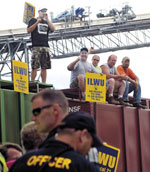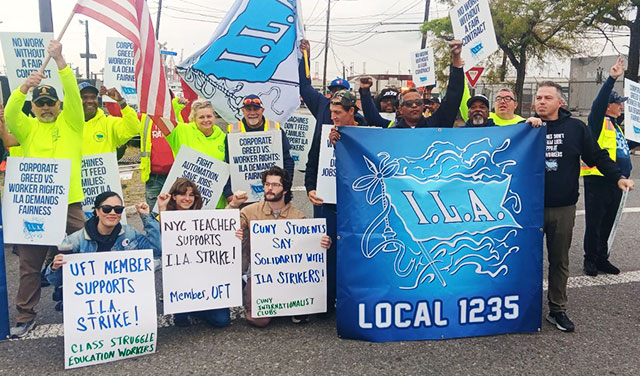
Showdown on West Coast Docks: The Battle of Longview
(November 2011).
click on photo for article

Chicago Plant Occupation Electrifies Labor
(December 2008).
click on photo for article

May Day Strike Against the War Shuts Down
U.S. West Coast Ports
(May 2008)
click on photo for article

December 2024
October ILA Strike “Suspended” After
Three Days,
January Showdown Over Bosses’ Automation Threat
ILA Longshore Workers:
To
Defeat Job-Killing Automation,
Strike for Union Control of
Tech!

Striking IlA Longshore workers at Sea Brook, Texas on the First day of the East and
Gulf Coast walkout. Strengthen the union, integrate the locals! (Photo: Mark Felix / AFP)
UPDATE, December 24 – After the brief strike of port workers on the U.S. East and Gulf Coasts in October, the unresolved issue was automation. On December 12, Donald Trump met with International Longshoremen’s Association president Harold Daggett and his son and ILA executive vice president, Dennis Daggett, who made their pilgrimage to Mar-a-Lago to ask for the president-elect’s blessing. They were not disappointed. Trump issued a statement supporting the union’s opposition to the introduction of automated machinery on the docks, pointing to the “record profits” of “these foreign companies” and “the harm it causes for American Workers.”
Some trade publications initially expected the maritime bosses to fold. “Is it game over for U.S. East Coast port employers?” asked Freightways, noting that Canada and Mexico bowed to Trump’s wishes in days. But the shippers have not relented. Another industry outlet, Sourcing Journal, opined that the employers may decide not “to waste another minute negotiating with the ILA, because it will be pointless.” The real question, it wrote, is “how long will the port strike last,” and the maritime bosses may figure that “if they're going to lose this battle, they could potentially benefit from a longer-lasting strike than the one we saw in early October.”
With no agreement in sight and the ILA saying talks are at an impasse, major shipping lines have issued advisories telling customers to anticipate that no cargo may move after the January 15 strike deadline. In one scenario, longshore workers walk out, a strike continues until Trump is inaugurated on January 20, whereupon he “bangs heads” and a face-saving deal is reached. But whatever the odds, any union “strategy” that banks on the whims of a multi-billionaire CEO of United States, Inc. can’t win lasting gains. With Trump, everything is “transactional.” There will be a quid quo pro. What will the unions give up?
While the Democrats like to posture as “friends of labor” even as they ban rail strikes (Biden) and send the Coast Guard to protect ships to scab terminals (Obama), Donald Trump’s recent posture of being pro-“American worker,” is just that, a pose, that could change in a flash. In his first inauguration he appointed virulently anti-union management-side lawyers to the National Labor Relations Board (NLRB). The co-leaders of Trump’s putative “Department of Government Efficiency,” Elon Musk and Vivek Ramaswamy, both sneeringly attacked the ILA, with the latter denouncing “union bosses’ efforts to coddle workers by limiting innovation.”
A real victory in the battle over job-killing automation will take an all-out fight for union control of technology, and a political fight against the politicians, parties and government of the bosses. No bargaining has been scheduled before the January 15 strike deadline. Now is the time to “get ready to rumble.”
DECEMBER 8 – The October strike by the International Longshoremen’s Association was solid, shutting down all ports on the East and Gulf Coasts. It was effective: from Maine to Texas, the booms on all the container cranes were up, no cargo moved. And it was short, only three days. On October 3, the ILA leadership under Harold Daggett told the 45,000 dockworkers to go back to work. Daggett and the United States Maritime Alliance (USMX) port and shipping bosses issued a joint statement that there was a “tentative agreement on wages,” with pay hikes totaling 61.5% over six years. Sounds like a good deal, but there’s a catch. The raises don’t go into effect until an overall pact is reached. Deadline: January 15. And now it’s the big one: automation.
Why did the shippers give in so quickly on wages? Because for the USMX, and for the ILA, the key issue is the union’s demand for a ban on automating operations that would eliminate jobs. Meanwhile, the old contract has been extended. But by postponing the showdown until after the holiday shopping season, longshore workers lost potential leverage. Moreover, as the strike came on the eve of presidential elections, Democrats worried that if President Joe Biden banned the strike under the slave-labor Taft-Hartley Act, it could lose votes for their candidate, Vice President Kamala Harris So the White House pressured both sides to come to a deal to end the walkout before it hit the economy hard. Daggett and the maritime bosses complied.
When it comes down to it, while the membership was fired up, for the longshore union leader, the October strike was largely a grandstand play, a chance to show some muscle without causing too much damage. The walkout, the first coastwise strike by the ILA since the 44-day strike in 1977, almost half a century ago, stopped container loading and unloading, and “ro-ro” cargo (roll on/roll off the ships), on the East and Gulf Coast ports which handle 59% of containerized cargo and 30% of passenger cars entering the U.S. Had it continued, the walkout would have cost up to $5 billion a day in lost production. Instead, the main event is now postponed to the dead of winter. On January 15, lame duck Biden will still be in office and Trump will be gearing up to be “dictator” on Day One.
Already the day after the walkout was called off, CNBC (4 October) headlined, “U.S. ports start 100-day countdown clock to new strike, and automation is poised to be the dealbreaker.”
In the October strike, the corporate media focused a lot of attention on the ILA chief, his “colorful language” (CNN), the high salaries for him (over $900,000) and his son, ILA executive vice president Dennis Daggett (over $700,000), his “sprawling mansion in New Jersey” and Bentley convertible (a New York Post favorite), and “questions about organized crime” (New York Times.) Some have compared Daggett to Teamster leader Jimmy Hoffa, also dogged by accusations of mob influence and racketeering. But Hoffa was a target of anti-labor witch-hunting (particularly by Democrat Robert F. Kennedy) for winning significant gains, notably the 1964 nationwide Master Freight Agreement (MFA). Harold Daggett is no Jimmy Hoffa.
In the lead-up to a possible second dock strike, capitalist hardliners are frothing about the ILA’s supposed “reckless gamble” that is supposedly threatening “the American economy for the benefit of a select few” (U.S. Chamber of Commerce, 29 November). The Chamber claims that “average pay” at the New York/New Jersey ports, for example, is “$350,000” a year. This is beyond absurd. Starting wages for ILA dockers under the existing contract are an outrageously low $20 an hour. After six years on the job, they top out at only $39/hr. Some may make six-figure annual incomes, but to get there they have to work enormous amounts of overtime. An ILA dock worker would have to put in 53 hours a week to break $100,000 a year.
Just to make ends meet after the latest rounds of inflation, many longshore workers work so many hours they hardly see their families, some sleeping in campers at the docks. West Coast dock workers, organized in the International Longshore and Warehouse Union (ILWU) make considerably more than those on the East and Gulf Coasts, currently $55/hr. reaching $60.85 in 2027. By that point, even with the “tentative” raises, ILA dockers `would still be making almost $3/hr. less than their ILWU counterparts. Meanwhile, USMX bosses raked in record profits by raising rates during the COVID pandemic. In 2022, according to the web site Statista, the container shipping industry made $208 billion net.
Forward to a Single Port Workers Union
Daggett has listed the remaining issues to be negotiated as jurisdiction, automation and opposition to cuts in health care benefits or in royalty payments (for previous job losses due to containerization). Not on Daggett’s agenda are workers’ pensions, which are negotiated on a company-by-company or port-by-port basis and are far inferior to the ILWU pension plan which is established on a coastwide basis. Philadelphia and Houston dockworkers have no pensions at all. ILA workers should have a coastwise pension and medical plan. Furthermore, ILA and ILWU should have their contracts expire at the same time, preparing for a powerful nationwide dock strike that could lay the basis in struggle for a single national port workers union.
In October, ILWU president Bobby Olivera brought a contingent to show solidarity, pledging not to handle cargo diverted to the West Coast during the ILA strike. Daggett brags about how in ’77 he went to the West Coast to set up picket lines at diverted ships that the ILWU honored. But two years ago, when ILWU locals took job actions during contract negotiations, causing cargo to be diverted to the East and Gulf Coasts, the ILA chief ignored pleas not to handle the cargo. While Daggett is currently posing as a militant, he is a business unionist at core, inviting the USMX chairman to ILA conventions and hobnobbing with capitalist politicians, in particular with Donald Trump, with whom he says he has “a long relationship going back decades” (CNN).
 ILA
president Harold Daggett (right) and executive vice
president Dennis Dagget with U.S. president-elect Donald
Trump, at his Mar-A-Lago resort, December 12.
ILA
president Harold Daggett (right) and executive vice
president Dennis Dagget with U.S. president-elect Donald
Trump, at his Mar-A-Lago resort, December 12. (Photo: ILA / Facebook)
The New York Times (4 October), house organ of the liberal capitalist establishment, wrote that “The Union Leader Who Shut Down the Ports Is Playing Hardball.” Not really. The Internationalist has long insisted that “Labor’s Gotta Play Hardball to Win!’ But that’s not Daggett’s game: he has headed the union since 2011, yet the pay for ILA longshore workers is still miserable. Instead, he is playing the angles. He sees an opportunity and is taking it. A year ago, Daggett visited Trump in the latter’s Mar-a-Lago resort, where the ILA leader says they talked about the threat of automation to union jobs. Now, in keeping with Trump’s “America First” agenda, Daggett is railing against “foreign-owned” shipping lines. In fact, the USMX is greatly influenced by American terminal operators like Carrix (parent of SSA Marine).
More than any other industry, shipping has always been international in nature, going back to ancient times. Therefore, any struggle against the maritime bosses cannot be won on the basis of a nationalist appeal, but only with an internationalist program. That program must take aim at the capitalist system as a whole, not just an individual employer, or port, or limiting the struggle to a national framework. That is especially true of the main issue in this fight: automation of the ports. The pressure for this is intensified because of the huge expansion of international manufacturing under the guise of “globalization,” where a final product may have components made in multiple countries, all dependent on shipping, and on their on-time arrival.
The supply-chain bottlenecks during and after the COVID-19 pandemic led governments as well as maritime monopolies to push for automation of port operations. Yet various studies and surveys show that introducing automated equipment is hugely expensive, and is not necessarily more efficient in terms of speeding up loading and unloading. What it does do is slash labor costs, and jobs. The industry has been growing steadily, with cargo moved by ship nearly tripling from 1990 to 2021 (from 4 to 11 billion tons). Especially because of the requirements of “just-in-time” manufacturing, port workers have tremendous potential power to defend their livelihoods. What’s required is a fighting leadership with a program to use that power.
Maritime Bosses Can’t Automate
Their Way Out of Port Bottlenecks

Internationalists at ILA picket line in Port Newark, NJ, on October 3. (Internationalist photo)
Internationalists, including youth from the City University of New York and trade-union supporters in Class Struggle Education Workers were present at New Jersey strike lines each day of the three-day ILA walkout. Automation was the main issue for most of the workers we talked to on the picket lines and at rallies. It threatens the jobs of all longshore workers, and has already led to sharp cuts of jobs at many ports around the world. The bosses dream of replacing workers – and busting the unions – with robot cranes, autonomous vehicles in port yards and processing trucks entering the port without labor. The Danish imperialist carrier Maersk has already done that last one at Mobile, Alabama and other ports, in violation of the current ILA contract.
The union’s stand is categorical: no loss of jobs from automated machinery or processes:
“Furthermore, the ILA is steadfastly against any form of automation — full or semi — that replaces jobs or historical work functions. We will not accept the loss of work and livelihood for our members due to automation. Our position is clear: the preservation of jobs and historical work functions is non-negotiable.”
– International Longshoremen’s Association statement in response to USMX (1 October)
Right! And those words are going to require hard action come January 15. All labor must support the ILA to the hilt in this battle, which is in the vital interest of all working people. This means, first of all, the ILWU, which in its latest contract (which we opposed) greenlighted the Pacific Maritime Association shippers to introduce automated equipment, so long as the labor is performed by ILWU members. For years, sellout union leaders have let the bosses get away with slashing jobs and shutting down whole plants on the grounds that they can’t violate capitalist legality. Wrong! It takes is a fighting leadership with a class-struggle program.
In the big business media, there is a lot of talk that the U.S. is a “laggard” in terms of port automation. Forbes (3 October), which calls itself “the capitalist tool,” claims “the U.S. risks becoming increasingly less competitive in the global shipping landscape.” Hello?! When it comes to U.S. imports and exports, where else are the shippers going to unload or load cargo? Canada? Longshoremen in the Canadian East Coast ports of Halifax and St. John are organized by the ILA, and the West Coast ports of Vancouver and Prince Rupert by the ILWU. And Montreal dock workers in CUPE were just locked out by the employers, and then forced into binding arbitration by the widely despised government of Justin Trudeau.
Besides, out of 1,300 global container terminals, only 62 (less than 5%) were automated or even semi-automated as of 2022, according to a paper in Maritime Economics & Logistics (August 2023). This fight has nothing to do with “competitiveness.” It also is not about “increased import prices” due to dock workers’ pay, which is a tiny part of final product cost. As for “inefficiency,” a report to Congress by the U.S. Government Accountability Office on “Port Infrastructure” (March 2024) noted that “automated cargo handling equipment can slow operations, as the equipment may not move containers as quickly as conventional equipment.” Also, automated equipment breaks down more often, is less able to work in rain or fog, and about 24/7 operations, truckers can’t drop off boxes when offsite warehouses are closed.
Another report, the Container Port Performance Index 2023, by the World Bank and S&P Global, showed that of the top 100 top-ranked ports in terms of efficiency, those with the most experience with automated equipment going back to before 2000, are well down the list, with Singapore at 17 and Rotterdam at 91, just ahead of New York/New Jersey at 92. Then there’s the cost. Automated gantry cranes, and other cargo moving equipment are hugely expensive, so much so that, according to the GAO report, some port operators “said it could take 10 to 20 years or more to recover the costs associated with adopting automated cargo handling equipment, at which point the equipment would be reaching or exceeding its operational life expectancy.”
So if it’s not about competitiveness, efficiency, speed of operation or lowering costs, why are the USMX shipping companies insisting on the right to introduce automation? It’s all about union-busting: the maritime bosses don’t want to have powerful workers organizations at the pivotal point of world commerce. They want to break labor’s power by eliminating jobs. And the capitalist governments don’t want to disrupt commerce. Democrat Biden, the self-proclaimed most pro-union president in U.S. history, not only outlawed a rail strike in 2022, he didn’t enact his Protect the Right to Organize (PRO) Act, even as Dems led both houses of Congress. As for Trump, in 2023 he praised his new “efficiency czar” Elon Musk for firing striking workers.
The capitalists’ supposed knockout “argument” is that “Striking port workers are trying to fend off the inevitable” (Axios, 2 October). But even if technological advance is inevitable, the central issue in this struggle, as a New York Times (30 September) article pointed, is “Who controls the technology” and what is its impact on the workers. It’s not just about retraining programs and the like. Longshore workers’ jobs are grueling and dangerous, and they work insanely long hours to maintain their standard of living. Any labor-saving technology in the ports should enable dock workers to earn more and work a lot less, so they can have a life. But that will never happen so long as the profit-gouging capitalists are in control.
Automation has been at the core of dock workers’ struggles for decades. ILWU founder leader Harry Bridges, although touted as a “progressive” and always under attack by the feds, signed a disastrous “mechanization and modernization” contract in 1961. The M&M deal gave the PMA pretty much a free hand to introduce containerization, in exchange for bonuses and a pay guarantee plan (PGP) for a week’s pay even if insufficient shifts are called, but only for the category of “A” members. As a result, ILWU membership fell from 65,000 in 1959 to 35,000 longshore workers in 1971 and barely 15,500 “A” and “B” workers today. This division greatly weakens the ILWU. We say abolish the A/B and “casual” system now! And in the ILA, the two-thirds of the members who work “on call” have no assurance of stable income at all.
In the 2022-23 ILWU bargaining, when the union worked for almost a year without a contract, the Internationalist Group wrote, in a leaflet distributed on the West Coast waterfront:
“Marxists do not oppose new technology as such. What we oppose is the companies seizing the fruits of technological advances – paid for with the sweat, blood and lives of workers – and then throwing the workers onto the scrap heap while the bosses rake in the profits.
“How can workers stand up to the maritime bosses’ robo juggernaut? … A shortened workweek with no loss in pay would create thousands more jobs. In addition, class-struggle militants would fight for union control of technology. For starters, this would include demanding that any steps to automate work be agreed to by the union, with full guarantees for workers’ jobs.”
–“Fight for Union Control of Tech,” The Internationalist leaflet, 6 August 2022
By union control of tech we mean just that, the workers decide, not some “labor-management” committee to “consult,” which the ILA and USMX already have. Along with the call for union control of safety by committees empowered to shut down unsafe operations, these “transitional demands” go beyond simple trade-unionism. As in Leon Trotsky’s 1938 Transitional Program, calls for workers control of production point to a struggle for socialist revolution. Can such demands be won under capitalism? It depends on the balance of class forces overall, and forging a leadership with the program and determination to wage all-out class struggle on the waterfront. ■
Forge a Class-Struggle Leadership
In the pandemic, as white-collar employees worked from home, dock workers braved the elements, often with inadequate or no protective equipment. The shippers, for their part, netted $400 billion in profits in 2020-2023, more than in the entire 60+ years since containerization was introduced (CNN, 27 September). Their push to bring in job-killing technology is part of that profit-gouging, which continues today as the container shippers have raised rates as Houthis in Yemen attacked shipping in the Red Sea in solidarity with the Palestinians under siege in Gaza. But it’s not just about money. As Karl Marx and Friedrich Engels wrote in The Communist Manifesto, every class struggle is a political struggle.
As the U.S. poured deadly munitions into Israel and dispatched the Navy to ride shotgun for maritime companies in the Red Sea, the Palestinian General Federation of Trade Unions called on labor internationally to refuse to transport war cargo to Israel. On the West Coast, ILWU Local 10 passed a motion to refuse to handle military cargo to Israel. (The resolution was shot down by the union bureaucracy at its convention in June.) Under Harold Daggett, the ILA did the exact opposite, pledging on September 25 that “we will proudly continue to work all military shipments beyond October 1st, even if we are engaged in a strike.” This betrayal undermined the effectiveness of the strike and aided the imperialists and Zionists in their genocidal war on Gaza.
Likewise with military cargo to Ukraine in support of the imperialist U.S./NATO proxy war against Russia. Class-conscious workers call on longshore unions worldwide to “hot cargo” (refuse to handle) military goods to Israel and Ukraine! In 2019 Dennis Daggett became general coordinator of the International Dockworkers Council (IDC), which was once the organization of more militant port unions. In the 2021 war on Gaza, the IDC issued a statement “strongly condemn[ing] the massacre that is taking place against the Palestinian people at the hands of Israel” and called on dock workers not to handle war materiel. But under the Daggetts, even as the dock union in Barcelona, Spain – headquarters of the IDC – declared it would refuse to handle war cargo, the IDC has done zero against the slaughter in Gaza.
To win important union battles and organize the unorganized, labor must wage sharp class struggle, using tactics like mass militant picket lines that no one dares cross (or work behind) and solidarity strikes that defy Taft-Hartley, other anti-labor laws and/or “no strike” contract clauses. The ILA historically has been weakened by racial divisions within the union. In Southern locals, dockers are overwhelmingly black, while better-paid checkers are mainly white and are in separate locals. Even in Newark/Port Elizabeth, New Jersey ports, longshoremen doing the exact same work have two different locals, one mainly “white” and the other mainly “black.” We say: Integrate the locals and the leaderships!
The ILA, with a majority black membership, should take the lead in defending black people under attack. In the 2020 eruption of mass protest against racist cop terror after the cop murder of George Floyd, the ILWU shut down all the West Coast ports on Juneteenth as a powerful action against racial oppression. The ILA tops, in contrast, refused appeals for a shutdown, instead took a knee for nine-and-a-half minutes (the time Minneapolis killer cop Chauvin had his knee on George Floyd’s neck), in a measly lunch hour “protest,” along with the USMX bosses! This also raises the role of the police. After the three-day October strike, Daggett praised port police for maintaining “peace and safety.” In a hard-fought strike, those cops would do the bidding of the bosses in herding scabs, and attacking those defending the picket line.
Another major issue is organizing port truckers and the warehouses to which they transport containers. As the maritime bosses seek to slash longshore jobs, it is vital for the dock unions to extend their reach to these key sectors in the logistics supply chain. Around the country, truckers are overwhelmingly non-unionized, and a large proportion work for trucking companies; even owner-operators could be organized in a union-linked cooperative. And in order to survive and strengthen, the port unions must take the lead or join with other unions in organizing the giant non-union warehouses, like Amazon and Walmart. The book by Harvey Schwartz, The March Inland (1978) spells out the importance of the ILWU organization of warehouses in the 1940s.
In an all-out ILA strike over automation these kinds of militant tactics and labor solidarity will be all the more important. To ensure the mobilization of the membership, and its role in winning a contract that meets their demands, there should be elected strike committees and an elected negotiating committee. If cargo is diverted, the ILWU must refuse to handle it. If an ILA strike is hit with Taft-Hartley or court injunctions or police violence, the ILWU must shut down the West Coast ports in solidarity! And rather than kneeling before the bosses’ parties, workers and the oppressed need a class-struggle workers party, an internationalist party fighting for a workers government. An injury to one is an injury to all! ■
The
Battle of Charleston (2000): International
Solidarity with Black ILA Longshore Workers
 ILA longshoremen in
Charleston, SC, face off with army of scabherding
police, January 2000. (Photo:Mic Smith)
ILA longshoremen in
Charleston, SC, face off with army of scabherding
police, January 2000. (Photo:Mic Smith)Understanding the role of the police as the armed fist of the capitalist rulers is key to the link between reviving the workers movement and the fight for black liberation from the systemic racism of U.S. capitalism. An example was the struggle in Charleston, South Carolina by ILA longshoremen in overwhelmingly black Local 1422 (and the smaller, mainly white Local 1771) to beat back an attempt to bring in a non-union company to work the docks. Three days after Local 1422 had joined in a mass protest against the Confederate flag flying at the statehouse in the state capital, on 20 January 2000, 150 ILA members came out to stop a scab operation at the docks. In response, an army of 600 cops savagely beat and arrested longshoremen.
Five longshoremen – four black, one white – were vindictively hit with felony charges of “felonious riot.” Their defense became the focus of international solidarity campaign by the nascent IDC, spearheaded by Jack Heyman of ILWU Local 10, as Spanish dockers in Barcelona and Valencia refused to work the same ship of the Nordana (Norwegian-Danish) cargo line from the scab operation in Charleston. After months of mobilization, the charges against the five were later reduced to misdemeanor, they were released from house arrest and Nordana agreed to end its scab operation in Charleston, all as a result of the international campaign, which was boycotted by the ILA leadership under John Bowers.
For the story of this extended battle, see our article, “Defend the Charleston Five!” The Internationalist No. 10, June 2001 and the book by Suzan Erem and E. Paul Durrengerger, On the Global Waterfront: The Fight to Free the Charleston Five (2008) which synthesize the lessons for militant trade unionism. In the wake of that militant struggle led by Local 1422, the previously all-white checkers ILA Local 1771 integrated and accepted black workers into membership. This is a key lesson for all ports where ILA locals are still largely segregated. On the basis of the unity of dockers and checkers that this fight fostered, the Charleston dock workers continued the struggle, initiating a campaign to win representation of crane operators in the port, who had been excluded from the union as state employees. This effort recently concluded in victory, as the ILA now includes Charleston crane workers. ■